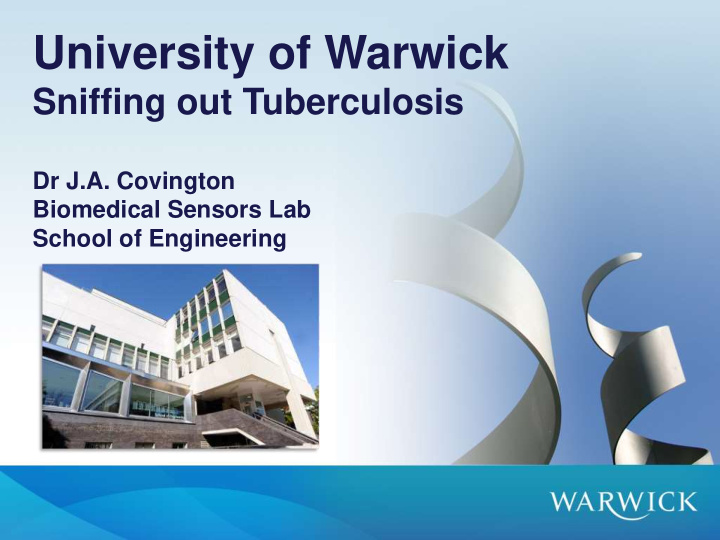



University of Warwick Sniffing out Tuberculosis Dr J.A. Covington Biomedical Sensors Lab School of Engineering
A life in smell… H 2 Flow Sensor Filter Detector
Motivation… • Point of care • Rapid • Patient acceptable • Low-cost • Simple • Hospitals/Home • Developing countries
Warwick/University Hospital Coventry & Warwickshire • Diseases investigated… Brain Cancer/Schizophrenia – Bile acid malabsorption Eye infections Lung diseases Ear/Nose/Throat – Bladder/prostate Cancer Metabolic diseases – Coeliac's disease Liver disease – Clostridium difficile Gastrointestinal – Colorectal Cancer diseases – Crohns disease/Ulcerative colitis – Diabetes Bacterial infections i.e. MRSA & C-Diff – Hepatic encephalopathy Wound infections – Irritable bowel syndrome – Liver disease – Obesity Application of ‘Smell Technology’ – Pelvic radiation – Pre-term labour
TB Breath “sniffers” • Testing of breath for TB targeted for decades • Show promise… – Most high-end analytical instruments (GCMS etc.) – Others based on electronic nose • However, limited by the core sensor technology or by carrier gas • Hence, each system needs to be individually configured and will drift significantly over time
Ion Mobility Spectrometry - FAIMS • Used in chemical warfare detection • Applications for military or home security
Subject groups • 26 patients with confirmed TB – 7 smokers, 9 drinkers, Av. Age 46 (21-85) • 19 negative controls (from suspected patients and TB positive family members) – 4 smokers, 11 drinkers, Av. Age 39 (24-63) • Smear, Cx, T-spot etc. confirmation • Patients were asked not to eat/drink/smoke for 2 hours before collection
Sample Collection • All samples collected and tested at UHCW over 5 months • In-house breath capture system employing 3L tedlar bags • Breath samples tested on day of capture (stored in fridge) • Urine samples stored at -80 o C for batch sampling 9
Breath Results – Multivariate Analysis
ROC - Breath • Random Forrest Classifier • 10 fold cross- validation • AUC = 0.96 (95% CI: 0.93,1) • Sensitivity: 93% • Specificity: 94%
Conclusions & Further work • Initial breath results show promise…However – Sample collection & post testing challenging – Difficulty in sample introduction – Current technology now superseded – Requires validation with larger cohort – Investigation of ethnicity, diet etc. – Exploring commercial partnerships • Second development phase – But too expensive… – Creation of low-cost, small, portable instruments – Dedicated to harsh environments – WOLF research programme…
And thank you to… • Dr E. Adams – LSTM • Prof S. Ward – LSTM • Dr A. Sahota - UHCW • Dr R. Gowda – UHCW • Dr R. Arasaradnam – UHCW • Dr N. Sagar - UHCW • Ms S. Wurie - UHCW • And my PhD students…
Recommend
More recommend